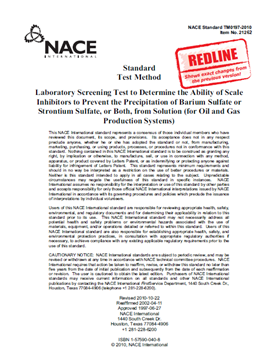Search
Standards
View as
Sort by
Display
per page
TM0193-2016-SG, Laboratory Corrosion Testing of Metals in Static Chemical Cleaning Solutions at Temperatures Below 93 °C (200 °F)
Product Number:
21223-SG
ISBN:
1-57590-104-8
Publication Date:
2016
$109.00
TM0193-HD1993-SG Laboratory Corrosion Testing of Metals in Static Chemical Cleaning Solutions at Temperatures Below 93 °C (200 °F)-HD1993
Product Number:
21223-HD1993
Publication Date:
1993
$179.00
TM0194-2014-SG (Spanish), “Monitoreo en Campo del Crecimiento Bacteriano en los Sistemas de Gas y Petróleo”
Product Number:
21266-SG
ISBN:
1-57590-192-7
Publication Date:
2014
$179.00
TM0194-2014-SG, Field Monitoring of Bacterial Growth in Oil and Gas Systems
Product Number:
21224-SG
ISBN:
1-57590-192-7
Publication Date:
2014
$109.00
TM0194-HD1994-SG Field Monitoring of Bacterial Growth in Oilfield Systems-HD1994
Product Number:
21224-HD1994
Publication Date:
1994
$179.00
TM0196-HD1996-SG Chemical Resistance of Polymeric Materials by Periodic Evaluation-HD1996
Product Number:
21226-HD1996
ISBN:
1-57590-009-2
Publication Date:
1996
$179.00
TM0197-2010, Laboratory Screening Test to Determine the Ability of Scale Inhibitors to Prevent the Precipitation of Barium Sulfate or Strontium Sulfate, or Both, from Solution (for Oil and Gas Production Systems)_
Product Number:
21228-SG
ISBN:
1-57590-040-8
Publication Date:
2010
$179.00
TM0197-2010-SG"Laboratory Screening Test to Determine the Ability of Scale Inhibitors to Prevent the Precipitation of Barium Sulfate or Strontium Sulfate, or Both, from Solution (for Oil and Gas Production Systems)" Redline<br><em>Redline versions of standards show the changes to the current edition of the standard since the last edition. Changes are shown in underline and strikeout. With the Red
Product Number:
21262-SG
ISBN:
1-57590-040-8
Publication Date:
2010
$109.00
TM0197-HD1997- Laboratory Screening Test to Determine the Ability of Scale Inhibitors to Prevent the Precipitation of Barium Sulfate and/or Strontium Sulfate from Solution (for Oil and Gas Production Systems)-HD1997
Product Number:
21228-HD1997
ISBN:
1-57590-040-8
Publication Date:
1997
$179.00
TM0198-2011-SG (Redline), "Slow Strain Rate Test Method for Screening Corrosion-Resistant Alloys for Stress Corrosion Cracking in Sour Oilfield Service" (Redline)<br><em>Redline versions of standards show the changes to the current edition of the standard since the last edition. Changes are shown in underline and strikeout. With the Redline, users will be able to quickly identify additions and d
Product Number:
21263-SG
ISBN:
1-57590-051-3
Publication Date:
2011
$109.00
TM0198-2016 "Slow Strain Rate Test Method for Screening Corrosion-Resistant Alloys (CRAs) for Stress Corrosion Cracking in Sour Oilfield Service"
Product Number:
21232-SG
ISBN:
1-57590-051-3
Publication Date:
2016
$179.00
TM0198-2020, “Slow Strain Rate Test Method for Screening Corrosion-Resistant Alloys for Stress Corrosion Cracking in Sour Oilfield Service”
Product Number:
TM0198-2020
ISBN:
1-57590-051-3
Publication Date:
2020
$109.00













